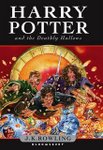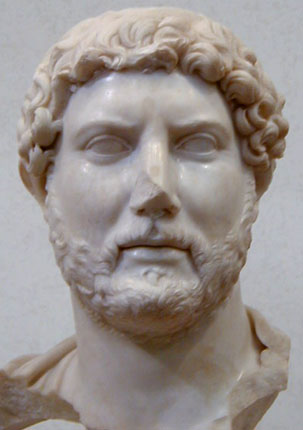 Even with the crowds of tourists and the A303 whizzing past, Stonehenge is awe-inspiring. Something ancient and inexplicable dwells at Stonehenge. Both Turner and Constable painted Stonehenge, in watercolors that give the impression of something elemental rising out of the landscape. In Tess of the D'Urbervilles, Tess and Angel Clare spend a night at Stonehenge, and its brooding, mysterious presence inspired Thomas Hardy to do what he did best: paint the dark landscape in words.
Even with the crowds of tourists and the A303 whizzing past, Stonehenge is awe-inspiring. Something ancient and inexplicable dwells at Stonehenge. Both Turner and Constable painted Stonehenge, in watercolors that give the impression of something elemental rising out of the landscape. In Tess of the D'Urbervilles, Tess and Angel Clare spend a night at Stonehenge, and its brooding, mysterious presence inspired Thomas Hardy to do what he did best: paint the dark landscape in words.The band of silver paleness along the east horizon made even the distant parts of the Great Plain appear dark and near; and the whole enormous landscape bore that impress of reserve, taciturnity, and hesitation which is usual just before day. The eastward pillars and their architraves stood up blackly against the light, and the great flame-shaped Sun-stone beyond them; and the Stone of Sacrifice midway. Presently the night wind died out, and the quivering little pools in the cup-like hollows of the stones lay still.
 The downs around Stonehenge are broad and lovely under a mild July sky. The ridges are dotted with ancient burial mounds, or barrows, that immediately reminded me of the eerie scene in The Fellowship of the Ring in which the hobbits, soon after leaving Tom Bombadil's house, cross the treacherous Barrow Downs. In the photograph at left, you can see the "heel stone" (with three people standing in front of it), framed in one of the arches of Stonehenge. On the morning of the summer solstice, the sun rises directly above the heel stone and shines through that arch into the inner stone circle.
The downs around Stonehenge are broad and lovely under a mild July sky. The ridges are dotted with ancient burial mounds, or barrows, that immediately reminded me of the eerie scene in The Fellowship of the Ring in which the hobbits, soon after leaving Tom Bombadil's house, cross the treacherous Barrow Downs. In the photograph at left, you can see the "heel stone" (with three people standing in front of it), framed in one of the arches of Stonehenge. On the morning of the summer solstice, the sun rises directly above the heel stone and shines through that arch into the inner stone circle. The mechanical clock in Salisbury Cathedral (ca. 1386).
The mechanical clock in Salisbury Cathedral (ca. 1386).It's remarkable that Stonehenge has been measuring out the months, and the risings and settings of the sun, for about four thousand years. Time was a theme in our last road trip of our English sabbatical year. We were conscious, the whole time, that in two weeks we will be leaving England. And at Salisbury Cathedral, we serendipitously stumbled upon the world's oldest mechanical clock, which has been ticking away inside the cathedral since 1386. The clock, which runs on weights and gears, has no face or hands, and only strikes the half-hours and hours.
 From Stonehenge, we drove down to Old Sarum—the ancient hill fort where the city of Salisbury originally stood. There was a Norman castle on the hilltop, overlooking the original Salisbury Cathedral. In the 13th century, however, it became clear that a waterless hilltop was not a perfect place for a city, and Sarum was moved downhill to modern Salisbury. The foundation stone of the new cathedral was laid in 1220, and the spire (England's tallest) was finished a hundred years later. Since it was built in such a relatively short time, the cathedral is architecturally unified, being all in the Early English Gothic style. In his Notes from a Small Island, Bill Bryson (an American whom the Independent has called the nicest man in Britain) says: "There is no doubt in my mind that Salisbury Cathedral is the single most beautiful structure in England and the close around it the most beautiful space."
From Stonehenge, we drove down to Old Sarum—the ancient hill fort where the city of Salisbury originally stood. There was a Norman castle on the hilltop, overlooking the original Salisbury Cathedral. In the 13th century, however, it became clear that a waterless hilltop was not a perfect place for a city, and Sarum was moved downhill to modern Salisbury. The foundation stone of the new cathedral was laid in 1220, and the spire (England's tallest) was finished a hundred years later. Since it was built in such a relatively short time, the cathedral is architecturally unified, being all in the Early English Gothic style. In his Notes from a Small Island, Bill Bryson (an American whom the Independent has called the nicest man in Britain) says: "There is no doubt in my mind that Salisbury Cathedral is the single most beautiful structure in England and the close around it the most beautiful space." The tomb of William Longspee, Earl of Salisbury, who died in 1226.
The tomb of William Longspee, Earl of Salisbury, who died in 1226.In the Cathedral Close, there's an "outstanding" (Bill Bryson) little museum with exhibits on Stonehenge and the history of Salisbury, including three wonderful Turner watercolors of the cathedral. One of the oddities is a well-preserved rat discovered inside the skull of William Longspee, a 13th-century Earl of Salisbury, when his tomb was opened a century or two ago. It was suspected that Longspee may have met his death by poison, and, in fact, traces of arsenic were found inside the rat! Longspee is interred in an unusual tomb with a stone effigy resting on a wooden chest. He was the first person to be buried in the new cathedral.
Also in the Cathedral Close is Mompesson House (pictured below), a National Trust property that, unfortunately, we didn't have time to visit on this trip. For me, the chief interest in Mompesson House is that it appeared as Mrs. Jennings' London residence in the superb Ang Lee film of Sense and Sensibility (1995).

After wandering around the cathedral, we headed back to the Market Square for a pub meal. I had forgotten that the pub to visit in Salisbury is The Haunch of Venison (fabulously haunted, and home to a mummified hand cut off in a fight during a card game in the pub), so we ended up eating in a distinctly ordinary pub before rushing over to the local cinema to watch The Simpsons Movie. (In case you're wondering, Louise, I had a pint of Ringwood Best Bitter.)
 The façade of the Odeon cinema, Salisbury.
The façade of the Odeon cinema, Salisbury.The movie was the boys' reward for putting up with cathedrals and Roman ruins (see the upcoming entry). One of the best things about the experience was the cinema itself, the Odeon, which was worthy of Diagon Alley. The lobby is built into a fifteenth-century banqueting hall, with much of its original façade still intact. From this medieval front, the cinema (opened in 1931) magically widens to accommodate four large screens. The website Cinematopia says: "Surely one of the most remarkable and outright spectacular cinemas in the country, the Odeon Salisbury shows both what can be achieved in cinema design and what twenty-first century audiences are missing in their modern picture palaces."
Next: A day at Fishbourne Roman Palace and Chichester Cathedral.



2 comments:
I am grateful that you didn't post Constable's picture of Salisbury Cathedral, for some reason I can't abide it.
The Simpsons. I am usually late to all things popular, and have to say that until moving to the US had so far managed to avoid them. However, I am a convert, and what a lovely cinema. I had never heard of it before.
I must protest at the choice of beer ;) You were in prime Hop Back Brewery territory, and you didn't manage to sample any Summer Lightening, shame on you!
I clearly didn't do my research, or I would have been able to blog about sitting down to a pint of Summer Lightning at the Haunch of Venison.
Constable's view of the cathedral from the Bishop's Garden is a bit of a greeting card, but I do like his view from the water meadows, with a dark sky and a weird rainbow. Very atmospheric, like the Stonehenge picture.
Post a Comment